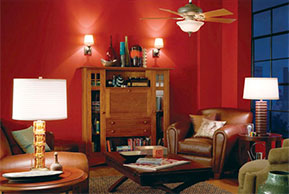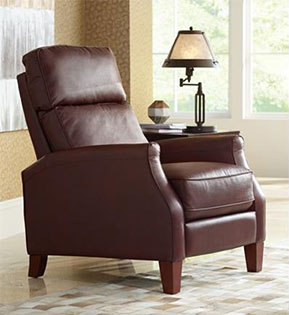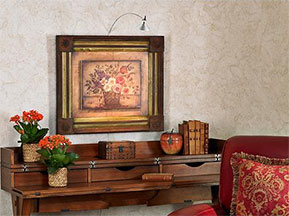The Basics of Amazing Light Design
by Rachel Lyon, Editorial Director for Direct from the Designers™
Lighting your home is more than sticking lamps in dark corners; you want to place the best kind of light in each room to give it the right atmosphere and make it comfortable to work or rest there. In addition to the benefit of illuminating spaces, you can also choose different types of fixtures to further develop the ambiance you’re going for. Here are the basics you need to know to help you build a functional light design in your home, focusing on the three major layers you should consider individually and balance together to optimize your interior.
Background Ambient Lighting
Ambient light is the most basic layer, and it’s already installed in every home. The lights that turn on when you flip a switch, whether recessed in the ceiling or hanging in a pendant fixture, usually provide ambient lighting, and they direct it downward to fill a room or a general area. Its main purpose is to uniformly illuminate—there shouldn’t be a gradient effect across a room. Evenly spaced bulbs should do it, but sometimes designers get creative with vaulted ceilings and other architectural elements to achieve the same goal. Light might actually be directed at the walls so it bounces back to fill the room.
Think of ambient light like the sun around midday. You shouldn’t need to know exactly where it is to get what you need from it. Whoever designed your house probably took this into account, and the electrician who wired it would have noticed an issue before you moved in, so there’s nothing big you have to do to improve this layer of lighting. What you can do is invest in good light bulbs, and fill every socket in each room with the same kind. You want evenness, first and foremost.
Focused Task Lighting
When you need to see something particularly clearly, the light that helps you do it is task lighting. It can be under-cabinet lights in the kitchen to help brighten countertops, or any type of lamp that places light over a desk or your shoulder so you can read effectively. This lighting layer is something you’ll plan for yourself in your home, and because it’s mostly made up of independent lamps and not fixtures, you can move it around until you get it right.
With task lighting, you have the opportunity to do more than illuminate. You should choose lamps that add something to your interior design. Everything from the simplest floor lamps to ornate pieces that just as well might function as art when not being used can enhance space even when natural light from windows is all that you need. Any opportunity to combine practicality with style should be taken, to give your home a great design with fewer elements and less effort—and you’ll really look like you know what you’re doing as a result.
Decorative Accent Lighting
Finally, when your home is otherwise well-lit for your purposes, you might notice that there are still some gaps in your light design. There could be shadows in corners or along walls, or perhaps the shapes in your architecture are creating dead zones. Employ accent lighting to highlight areas that are unnecessarily dark and specific points of interest. Brightening a shadowy corner will help you to see all of your space and expand your visual square footage, and placing a light to shine over displayed artwork will help you and any guests to appreciate it more. Why would you settle for showing any part of your home in a bad light, after all?
Accent lighting can take many forms for many needs. It can come as track lighting that you can move and dim as needed, or wall sconces to brighten where ambient light doesn’t quite reach, or as highly focused lamps that sit over individual picture frames. Anything that addresses a darkness issue like this can be your solution for accent lighting.
We say there are three lighting layers, but don’t think that you need to consider your light design as having three distinct checkboxes to fill. You might not need accent lighting at all, if your space is well-lit, or you could have fixtures that cover multiple categories. Consider track lighting, which you can position to shine in any direction; it can function as any of these layers depending on how you set it up. Just know the basics, know your needs, and you can come up with a great light design that makes your home comfortable and beautiful.
BROWSE HOME PRODUCT ARTICLES
- Creating a Spa-Like Master Bathroom »
- Designing a Water-Efficient Bathroom »
- Design a Modern Bathroom »
- View All Bathroom Articles »
- Building a New Home »
- Building a Duplex »
- Finding the Right Home Builder »
- View All Building Tips Articles »
- Adding the Right Columns»
- Decorative Touches for Your Interior»
- Shutters for Every Architectural Style »
- View All Columns & Millwork Articles »
- How to Use Specialty Laminates »
- Decorative Touches for Your Home's Interior
- View All Countertops and Surfaces Articles »
- What Goes Into a Great Deck? »
- Decorative Touches for Your Home's Interior »
- View All Decking Articles »
- Choosing Glass for Your Entry »
- Stylish Personas for Your Front Door »
- Using Sidelites and Transoms »
- View All Door Articles »
- Choose Siding for Your Region »
- Get the Most Out of Exterior Paint »
- Mixing Siding to Define Your Exterior »
- View All Exterior Articles »
- Finding the Right Home Builder »
- The Appeal of Small House Plans »
- Choosing the Perfect Floor Plan »
- View All Finding a Home Plan Articles »
- Colorful Flooring for Your Home »
- Designing With Different Widths»
- Chic, Neutral, Gray Flooring »
- View All Flooring Articles »
- Garage Doors That Add Curb Appeal »
- Caring for Your Garage Doors »
- Benefits of Insulated Garage Doors »
- View All Garage Door Articles »
- Reclaimed Products for Your Home »
- Building a Green and Stylish Home »
- Benefits of Building with SIPS »
- View All Green Building Articles »
- Cool Gadgets for Your New Home »
- Creating a Hi-Tech Home »
- Efficient Gifts for New Homeowners »
- View All Home Electronics Articles »
- Improve Your Home's Air Circulation »
- How to Improve the Air Circulation in Your Home »
- View All HVAC Articles »
- Bedrooms Designed for Sleep »
- Selecting a Fireplace for Your Home »
- Crafting a Luxurious Master Suite »
- View All Interior Design Articles »
- Design the Perfect Outdoor Space »
- Dive into a Beautiful Pool »
- Design a Sizzling Outdoor Kitchen »
- View All Outdoor Living Articles »
- Apps to Help You Pick Paint Colors »
- Create the Perfect Mood with Paint »
- How to Read the Color Wheel »
- View All Painting & Decorating Articles»
- Creating a Spa-Like Master Bathroom »
- High-Impact Kitchen Upgrades »
- Creating a Water Efficient Bathroom »
- View All Plumbing Fixtures Articles»
- Cladding That Complements Your Exterior »
- Reasons to Consider Prefinished Siding »
- View All Siding & Cladding Articles»
- All About Solar Powered Skylights »
- Natural Lighting for the Dark Corners of Your Home »
- Design a Better Bedroom with Skylights »
- View All Skylight Articles»




